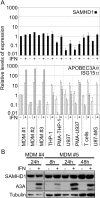Evidence for IFNα-induced, SAMHD1-independent inhibitors of early HIV-1 infection
- PMID: 23442224
- PMCID: PMC3598776
- DOI: 10.1186/1742-4690-10-23
Evidence for IFNα-induced, SAMHD1-independent inhibitors of early HIV-1 infection
Abstract
Background: Type I interferon (IFN) treatment of some cells, including dendritic cells, macrophages and monocytic THP-1 cells, restricts HIV-1 infection and prevents viral cDNA accumulation. Sterile alpha motif and HD domain protein 1 (SAMHD1), a dGTP-regulated deoxynucleotide triphosphohydrolase, reduces HIV-1 infectivity in myeloid cells, likely by limiting dNTPs available for reverse transcription, and has been described as IFNα-inducible. Myeloid cell infection by HIV-1 is enhanced by HIV-2/SIVSM Vpx, which promotes SAMHD1 degradation, or by exogenous deoxyribonucleoside (dN) addition.
Findings: SAMHD1 expression was not substantially influenced by IFNα treatment of monocyte-derived macrophages or THP-1 cells. The contributions of SAMHD1 to the inhibition of HIV-1 infectivity by IFNα were assessed through the provision of Vpx, exogenous dN addition, or via RNAi-mediated SAMHD1 knock-down. Both Vpx and dN efficiently restored infection in IFNα-treated macrophages, albeit not to the levels seen with these treatments in the absence of IFNα. Similarly using differentiated THP-1 cells, the addition of Vpx or dNs, or SAMHD1 knock-down, also stimulated infection, but failing to match the levels observed without IFNα. Neither Vpx addition nor SAMHD1 knock-down reversed the IFNα-induced blocks to HIV-1 infection seen in dividing U87-MG or THP-1 cells. Therefore, altered SAMHD1 expression or function cannot account for the IFNα-induced restriction to HIV-1 infection seen in many cells and cell lines.
Conclusion: IFNα establishes an anti-HIV-1 phenotype in many cell types, and appears to accomplish this without potentiating SAMHD1 function. We conclude that additional IFNα-induced suppressors of the early stages of HIV-1 infection await identification.
Figures




References
Publication types
MeSH terms
Substances
Grants and funding
- G1001081/MRC_/Medical Research Council/United Kingdom
- G1000196/MRC_/Medical Research Council/United Kingdom
- DA033773/DA/NIDA NIH HHS/United States
- AI070072/AI/NIAID NIH HHS/United States
- AI090935/AI/NIAID NIH HHS/United States
- T32 GM068411/GM/NIGMS NIH HHS/United States
- AI049781/AI/NIAID NIH HHS/United States
- 098049/WT_/Wellcome Trust/United Kingdom
- R01 DA033773/DA/NIDA NIH HHS/United States
- G0801937/MRC_/Medical Research Council/United Kingdom
- R01 AI049781/AI/NIAID NIH HHS/United States
- R01 GM104198/GM/NIGMS NIH HHS/United States
- AI077401/AI/NIAID NIH HHS/United States
- P01 AI090935/AI/NIAID NIH HHS/United States
LinkOut - more resources
Full Text Sources
Other Literature Sources
Research Materials
Miscellaneous

